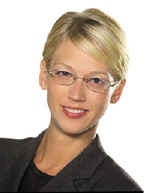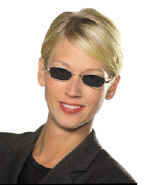How I...
Position photochromics
to post-Lasik patients
By Erinn Morgan
Can laser surgery actually increase your dispensing business? A remarkable thought, yet possible, at least according to some eyecare professionals co-managing patients who opt for Lasik.
One product which is garnering new interest from post-surgery patients is photochromics.
"The logic would seem to be that Lasik patients would have the surgery and then go away," says Dr. Monica Monica, an ophthalmologist with LakeView Vision in New Orleans.
"It's actually the opposite. They have made an investment in their eyes, and are looking for a seamless way to go through their day with good eyesight. Because they still need to resolve problems with glare and UV protection, laser surgery patients have become a wonderful population for photochromic technology," she says.
|
|
|
|
Transitions Optical's Next Generation photochromics are sunglass dark outdoors and clear indoors |
|
How much potential do photochromics have for growth in this area? While many report that Lasik is growing, dispensers say it is still a small percentage of their patient base who opt for the surgery. "We have a very large practice," says Steve Bennett, OD, FAAO, of Bennett Optometry, which has three professional offices in Ann Arbor, Mich. "But we probably do have about 10 to 15 patients a month who get laser surgery."
Estimates range from five to 10 percent of laser surgery post-op patients opting for photochromics all the way up to between 60 percent and 70 percent. The rewards with this product rely on the effort put into its presentation, say the experts.
"This end of the business is increasing because of my focus on it," says Monica. "It's a whole mindset that has to be incorporated into the practice. Otherwise, the Lasik patient will go away."
MANAGING THE PROCESS
Laser surgery has permeated the optical industry as a force that is here to stay, and many eyecare professionals have opted to work with this trend and try to co-manage their patients through the process. "When a patient wants laser surgery, we do all the pre-op and post-op," says Bennett, whose practice is affiliated with several laser centers in Detroit and Toronto, including TLC. "If there is any problem, we deal directly with the surgeon so the patient is not left hanging."
At LakeView Vision, a comprehensive ophthalmology practice, surgery is performed in-house. This keeps patients coming through the same doors, whether they are in search of contact lenses, eyewear, or laser surgery.
"In an environment of mega monster stores, we have a boutique-like, one-stop shop attitude," says Monica.
"We provide them with information on our different products and services while they are waiting. That's how some pre- and post-op patients are learning about photochromics."
Both Bennett and Monica present the photochromic option to laser surgery patients before and after their actual surgery. They agree that it is instrumental to provide an education prior to the operation about products that can enhance their vision even further post-surgery.
Once they are back in the exam room after Lasik, this is the time to open the discussion again and recommend photochromics as an option worth the investment.
|
|
|
|
Corning's SunSensors are an option for photochromic wearers |
MAKING THE CASE
If a patient has spent upwards of $3,000 for Lasik, why would he or she invest more in post-surgery eyewear?
Those who opt for laser surgery are interested in having trouble-free vision. That is what makes these people candidates for photochromic lenses, which can reduce post-surgery problems such as glare and distortion.
"These are patients who have chosen to enhance the comfort of their lifestyle with a refractive procedure," says Monica. "But it does not completely eliminate problems with glare and visual distortion, especially at night."
In fact, these patients have just invested heavily in getting rid of glasses, so it is likely they do not want to carry around several pairs of glasses.
"Photochromics are a seamless way to go from indoors to outdoors for laser patients. Additionally, many have not eliminated the need for reading glasses," says Monica.
The beauty of photochromics for these patients is that one pair serves many purposes. They can reduce glare and visual discomfort, or they can be made up as reading glasses for those who enjoy reading outdoors.
The added bonus is UV protection provided by photochromics, something many post-surgery patients are aware of and are concerned about. Typically active patients get Lasik--bikers, skiers, and swimmers--and for them UV protection is a necessity. Photochromics provide an easy way to get UV protection into streetwear.
Following this presentation path--educating surgery patients about UV, glare, and visual discomfort--makes the photochromic choice an easy one. It becomes even more clear if the doctor is discussing this option both pre- and post-surgery.
Bennett suggests that the dispenser also educate the patient about this appropriate choice. "It is initially brought up by the doctors. Then we will walk the patient out and say to the optician, 'Mrs. Jones is interested in photochromics.'"
Presentation aids make the benefits of photochromics more tangible. "Presentation aids are very important," explains Bennett. "They want to see what the lenses do, they want to touch them, feel them, and see what they look like."
The bottom line here is in educating patients from all angles before and after their procedure. "We present it in the exam room," says Monica. "The opticians back this up in the dispensary. It's about creating a stream of consciousness."






